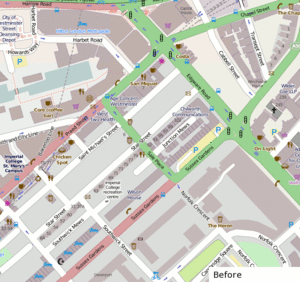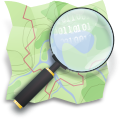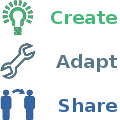User:Harry Wood
| ||
| ||
| ||
| ||
| ||
I support the license |
Harry Wood Homepage
Including blog category 'maps' although for very OSM focussed stuff I also write...
my OSM 'user diary'
I'm based in London.
OpenStreetMap roles
I'm a chief organiser of London OpenStreetMap mapping/pub meet-up events. This means I regularly commune with some core OSM technical folks over beers, which is a treat, although I'm trying (and largely failing) to make our OSMLondon events more widely appealing e.g. to new mappers. I'm also keen not to push myself as the only organiser of London events. Anyone can help!
I'm currently part of the Communication Working Group and trying to keep things like blog/twitter for OpenStreetMap up-to-date (Please let me know if you want to write a blog post for us)
I try to remain active within the Humanitarian OpenStreetMap Team. I served on the board of HOT during its formative years, and this is what brought me my 15 minutes of fame, with TV interviews on sky news and on BBC world news among others. It's pleasing to see HOT grow so big, but I feel we all need to try harder at joined up thinking between HOT and the rest of OpenStreetMap.
On the HOT board in particular, we had to worry about conflict of interest situations, so I had this /Declaration of Interests for the avoidance of doubt around my involvement in things.
Day job
Nowadays OpenStreetMap is a spare time hobby. I work at vivup.co.uk and my career is more around Ruby On Rails development, which in fact originally arose from my interest in OpenStreetMap. At one stage (2009-2010) I worked at CloudMade as part of a team working on furthering the goals of OpenStreetMap. Pretty awesome job working with my friends on doing my hobby! Sadly the VC funding was not to last, but I started learning Ruby on Rails back then. I then went on to build TransportAPI in rails, before moving to OpenCorporates (Both rails and both open data related). Nowadays my day job is tending to be less to do with maps or even open data, but still very Railsy.
My mapping
I do a lot of mapping both on-the-ground survey-based, and remote armchair mapping.
Surveying in London
I do survey-based mapping here in London and basically wherever else I find myself in the world. In London the nature of this mapping has shifted over the years. My diary has chronicled a lot of this, and my organisation of mapping parties is dictated by the mapping itches I personally want to scratch.
These days in central London I do a lot of POI mapping. Trying to map every shop. That's obviously a big job, and challenging because it's very difficult to know where the clusters of shops are, in order to figure out completion levels and plan mapping. Also challenging because shops change a bit. Some people say they change too much, so it's not worth mapping them, but I would disagree with that. But it does present a "maintenance mode" challenge. I'm in the habit of looking out, not just for missing clusters of shops, but also shops which look shiny and new. I do a lot of this mapping on a fly-by opportunistic basis. I used to find the Go Map!! iPhone app was very good for this. Nowadays I'm on Android with Vespucci. Also very good but takes a bit longer to learn. But anyway, for any slightly larger clusters of shops, or if I'm short of time, I just take lots of photos (geo-located by my phone)

1 Sketching in building outlines
2 then add surveyed data
I haven't done mapping party planning in a while, but I used to look at building outlines, as a thing which I really want to see completed, but also as reasonablish indication of areas which require more attention in London. I've written several diary entries about this planning. This means my mapping process, when it comes to more concerted planned mapping, is to sketch in building outlines from imagery, only in the area I'm planning to map, note any buildings which seem confusing in the imagery, and then go there, and photograph it all in order to fix any glitches in the building outlines, but mostly to get the shops.
It took a while for me to get excited about address mapping. It seemed a bit boring, but I was quite inspired by other London mappers, and these days I'm kind of hooked, as I feel responsible for gathering this detail in my area. Another hyper-detail thing I'm getting more interested in, is building heights. Buildings are everywhere, so this is almost as tedious as addressing in some ways, but at least it powers awesome 3D visuals.
I never use GPS these days. My old NaviGPS languishes unused. It's a bit sad really, because I had so much fun with getting traces in the early days, even pioneering WikiProject Whitewater Maps, and mapping by roller-blades! I should map some paths under the trees in Highgate Woods. That's really the only use I can think of for GPS traces in London nowadays.
Armchair mapping
"armchair mapping" involves mapping an area from aerial imagery, without planning to go there. Some people are quite strongly anti-armchair mapping, particularly in the UK, and this is a viewpoint I agree with, in the sense that the heart and soul of OpenStreetMap lies in the idea of mapping your own neighbourhood, but I can't agree that armchair mapping is always bad. This issue/debate verging on a religious war, is something which has bothered me since the very beginning.
When I first started mapping London way back in 2007, I championed an approach involving sketching in road layouts over the Yahoo! Aerial Imagery in some areas where I am not necessarily planning to complete the mapping myself. I thought a two-phase mapping approach would work well, as an efficient way of combining rapid aerial imagery sketching and on-the-ground hard work. I realise now that London is a place with enough of a mapping community (or potential mapping community) that we should probably tread more carefully. This realisation is also about recognising that armchair mapping can have a negative community-quashing effect. It's somewhere on a sliding-scale of evil towards Imports. Blatting in areas of coverage rapidly is not as helpful as you might think.
But it is helpful if, on balance, it's going to boost map coverage significantly without quashing the community too badly. That's a bit of a tricky thing to judge though. It seemed reasonable to do a lot of armchair mapping in the U.S. back in 2010 because there was very little community to speak of, and an almighty mess in the database created by the TIGER import. Nowadays it's starting to feel less reasonable, since we're getting to the point where local communities are starting to make maps by surveying there.
It seems reasonable to boost map coverage in situations where humanitarian organisations will benefit in the short term, especially tackling disasters. It seems reasonable to boost map coverage in low-tech parts of the world where the hope of a community of internet-savvy gadget toting locals doing mapping, is nowhere near reality. But maybe one day things will change. I think it's really exciting to think that when these places do start to get online, they'll have a pretty good map ready to use. At that point we need to encourage them to take pride and ownership over it. In the meantime we can try to explore ways of fostering this in a low-tech way. MapKibera project has a great story of doing that. HOT also tried a really great process using Field Papers in Lubumbashi. We should do more of this.
(Towards the end of my diagrams of OpenStreetMap talk is another place where I've distilled a lot of my thoughts on armchair mapping, including diagrams!)
Wiki
I started out as a wiki enthusiast. my fiddling with this wiki was a key avenue of contribution for many years. e.g. working on WikiProject Cleanup
Creating open content map images for wiki projects, was my initial attraction to OSM. For example I was a long time contributor to WikiVoyage (known as WikiTravel back then) where we had extensive discussions of mapmaking ideas and encountered many frustrations with the challenge of making open licensed maps. That was before OSM came along.
OSM models itself on wikipedia in many respects. Since the big API 0.6 development push of early 2009, we've had Changesets with comments, which in turn gives us a 'history' view, and a 'my edits' view. Simpler tools for Change monitoring and Change rollback, (perhaps built into the website?) would make it feel more wiki-like.
Coding
I'm a little bit ashamed of myself for failing to contribute much to the central codebase The Rails Port. Ruby on rails has been my day job for years now, which is maybe why I don't feel like doing this in my spare time!. I have done some bits and bobs. I created the first version of 'history' view for viewing changesets, partly because I was really keen to see the OpenStreetMap interface emulate a wiki (these days it's looking much less wiki-like, but maybe that's not such a bad thing). Contributing to the central codebase has been made easier over the years, although it feels like it's subject to a lot of scrutiny (rightly!). For me it doesn't feel like the lowest hanging fruit, but that's because I do a lot of dabbling and not much serious coding...
I've done quite a lot of random coding in and around OpenStreetMap, tending to mostly throw things together using php if I need server-side web stuff, ruby for stand-alone data processing scripts, and a whole lot of javascript for web mapping fun. There's a few new ideas I'm working on, and ideas sitting on my pile here: /hack ideas
I made a little tool to let you download Notes as KML on your phone, for use with Organic Maps.
I made a Edit Tracker rankings/stats diff reading thingy, which was used during the UK schools mapping project. Actually it started life for Big baseball project 2011.
Back in the early days when people first started using OpenLayers to embed OSM maps, I created (documented really) the OpenLayers Simple Example on the wiki. I went on to create a whole bunch of javascript examples to help developers use OSM, which I sometimes add to and try to maintain. It needs a general update now though. I also wrote the first version of this on switch2osm.org.
My speciality seems to be cobbling together various OSM map displays in fact. I was simultaneously ashamed and proud of Redaction bot progress map. It was dreadful cobbled together un-scalabled code, but very useful and popular for a few weeks! Older things like TIGER fixup/250 cities, Waychains TIGER fixup tools for early US TIGER fixup. XAPI query builder and bing OSM comparison are still popular. Some other bits and bobs on http://harrywood.co.uk/maps/
Years and years ago I made a couple of MediaWiki Extensions for OpenStreetMap, enabling you to embed a static map image or a slippy map into a wiki page here. They were pretty basic, but were used by lots of people on this wiki for about 10 years. They have now been replaced. I'm surprised how long that took! Other things in php include Phprender experiments and getting OAuth working for a basic editing demo (which has since broken)
In java I dabbled in JOSM coding to create the JOSM/Plugins/WayDownloaderPlugin. I also made an osmosis 'simplify' plugin (as part of the Waychains TIGER fixup) and I made a little java tool, tiletabber, for creating MapInfo .TAB files for tilesets.
User boxes!
In the interests of properly categorising myself...
|
...I probably know Portuguese better than French and German these days, having married a Brazilian
| Harry Wood volunteers at Humanitarian OSM Team. |
| This user agrees that Kayaking is the best sport in the world. |
| This user hails from Europe |
| Harry Wood submits data to OpenStreetMap using JOSM. |
| Harry Wood uses a macOS computer. |
| This user is a 2011 Wimbledon tennis champion! |
| This user joined in with Big baseball project 2011! |
- User en
- User en-N
- User de
- User de-1
- User fr
- User fr-1
- User pt
- User pt-1
- GitHub users
- Mastodon users
- Twitter users
- Member of OSMF
- ODbL Supporter
- Humanitarian OSM Team Volunteers
- Whitewater users
- Users in Europe
- JOSM users
- MacOS users
- Wiki Team
- Wimbledon tennis champions
- Baseball champions
- Wikipedians
- Users in the United Kingdom
- Users in London
- Users in Yorkshire
- CloudMade


